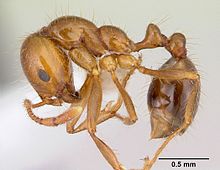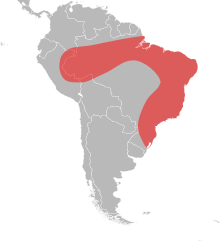| Solenopsis saevissima | |
|---|---|

| |
| Solenopsis saevissima worker | |
| Scientific classification | |
| Domain: | Eukaryota |
| Kingdom: | Animalia |
| Phylum: | Arthropoda |
| Class: | Insecta |
| Order: | Hymenoptera |
| Family: | Formicidae |
| Subfamily: | Myrmicinae |
| Genus: | Solenopsis |
| Species: | S. saevissima
|
| Binomial name | |
| Solenopsis saevissima (Smith, 1855)
| |

| |
| The natural range of Solenopsis saevissima | |
Solenopsis saevissima, commonly known in Brazil as formiga de fogo, formiga-vermelha (red ant), or formiga-lava-pes,[1] is one of more than 185 species in the genus Solenopsis.[2] It, along with 13 other species, is also a member of the Solenopsis saevissima species group which are popularly known as fire ants.[3]
Although it is indigenous to South America, it has been apparently imported to Africa, Guadalupe[4] and the Galápagos Islands. To date there is no evidence of it in the United States.[5][3] S. saevissima is known for its powerful and painful sting, hence the name "fire ant". It is a pest in horticulture[6] and one proposed method of control is to introduce the scuttle fly phorid into its habitat.[7]
Little information about S. saevissima and its behaviors is known or studied except from a few reports in Brazil[8][9] and in French Guiana.[10] The species is apparently all polygynous across the native habitat, and highly aggressive.[9]
- ^ Lenko, Karol (1979). Insetos no Folclore. Sao Paulo, Brazil: Conselho Estadual de Artes e Ciêncais Humanas.
- ^ Pitts, James; McHugh, Joseph; Ross, Kenneth (2005). "Cladistic analysis of fire ants of the Solenopsis saevissima species-group (Hymenoptera: Formicidae)" (PDF). Zoologica Scripta. 34 (5): 493–505. doi:10.1111/j.1463-6409.2005.00203.x. S2CID 85792334.
- ^ a b Tschinkel, Walter (2006). The Fire Ants. The Belknap Press of Harvard University Press. pp. 13–14. ISBN 978-0-674-02207-2.
- ^ Wetterer, James K. (2013-08-29). "A South American fire ant, Solenopsis nr. saevissima, in Guadeloupe, French West Indies". Biological Invasions. 16 (4): 755–758. doi:10.1007/s10530-013-0534-8. ISSN 1387-3547. S2CID 22099573.
- ^ Taber, Stephen (2000). Fire Ants (1st ed.). Texas A&M University Press. pp. 103–104, 241. ISBN 978-0-89096-945-8.
- ^ Lunz, Alexandre M.; Harada, Ana Y.; Aguiar, Tanice da S.; Cardoso, Andreza S. (April 2009). "Danos de Solenopsis saevissima F Smith (Hymenoptera: Formicidae) em Paricá, Schizolobium amazonicum". Neotropical Entomology. 38 (2): 285–288. doi:10.1590/S1519-566X2009000200019. ISSN 1519-566X. PMID 19488521.
- ^ Harris, Richard; Berry, Jo (11 March 2011). "Solenopsis saevissima (Smith)" (PDF). Land Care Research. Retrieved 11 March 2011.
- ^ Fox, Eduardo Gonçalves Paterson; Solis, Daniel Russ; Rossi, Mônica Lanzoni; Delabie, Jacques Hubert Charles; de Souza, Rodrigo Fernando; Bueno, Odair Correa (2012). "Comparative Immature Morphology of Brazilian Fire Ants (Hymenoptera: Formicidae:Solenopsis)". Psyche: A Journal of Entomology. 2012: 1–10. doi:10.1155/2012/183284. hdl:11449/73193. ISSN 0033-2615.
- ^ a b Fox, Eduardo Gonçalves Paterson; Pianaro, Adriana; Solis, Daniel Russ; Delabie, Jacques Hubert Charles; Vairo, Bruno Cunha; Machado, Ednildo de Alcântara; Bueno, Odair Correa (2012). "Intraspecific and Intracolonial Variation in the Profile of Venom Alkaloids and Cuticular Hydrocarbons of the Fire AntSolenopsis saevissimaSmith (Hymenoptera: Formicidae)". Psyche: A Journal of Entomology. 2012: 1–10. doi:10.1155/2012/398061. hdl:11449/73386. ISSN 0033-2615.
- ^ Lenoir, Alain; Devers, Séverine; Touchard, Axel; Dejean, Alain (2015-07-02). "The Guianese population of the fire antSolenopsis saevissimais unicolonial". Insect Science. 23 (5): 739–745. doi:10.1111/1744-7917.12232. ISSN 1672-9609. PMID 25953710. S2CID 32420753.